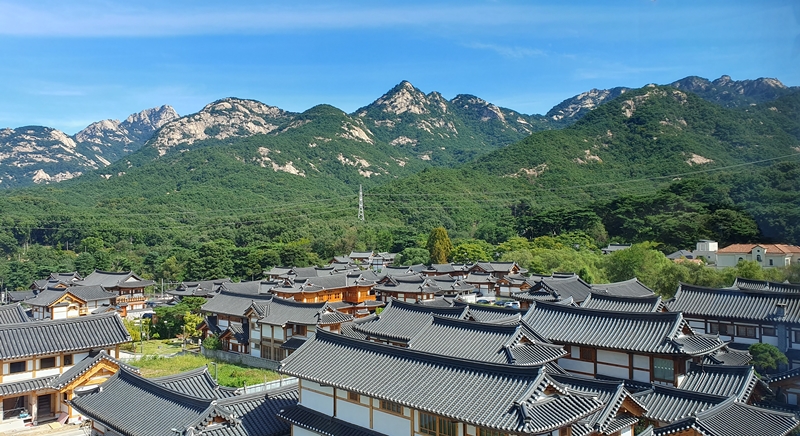
Eunpyeong Hanok Village is located at the foot of Bukhansan Mountain in Seoul's Eunpyeong-gu District.
By Lee Kyoung Mi
Eunpyeong Hanok Village is at the foot of Bukhansan Mountain in Seoul. While a Korea.net team walked on a quiet village road under the sunny weather, the scent of wood, the main component of Hanok (traditional house) was everywhere.
The Seoul Metropolitan Government is hosting this year's Seoul Hanok Week from Sept. 18-27 to promote the value and appeal of Hanok. Exhibitions, interactive programs, performing arts and tours are being held in the village as well as Bukchon Hanok Village and Seochon Village to offer enjoyment of Hanok in diverse ways.
The event "Open House Hanok," which allows visitors to enter such traditional homes, whose interiors are usually off-limits to the public, was held on Sept. 24 from 11 a.m. to 4 p.m.
The nine homes open to the public throughout the event were Hwigyumjae, Arumjigi's Anguk-dong Hanok, Mionga, Chung Won San Bang and Yangyudang in the Bukchon village and Seoheejae, Bzign Hanok, Jeongdaun House and Jinkwansa Korean Cultural Experience Center in the Eunpyeong village.
Korea.net that day visited the Eunpyeong village, which sees relatively fewer foreign visitors, and looked around Seoheejae, Jeongdaun House and Bzign Hanok, all three of which have residents.
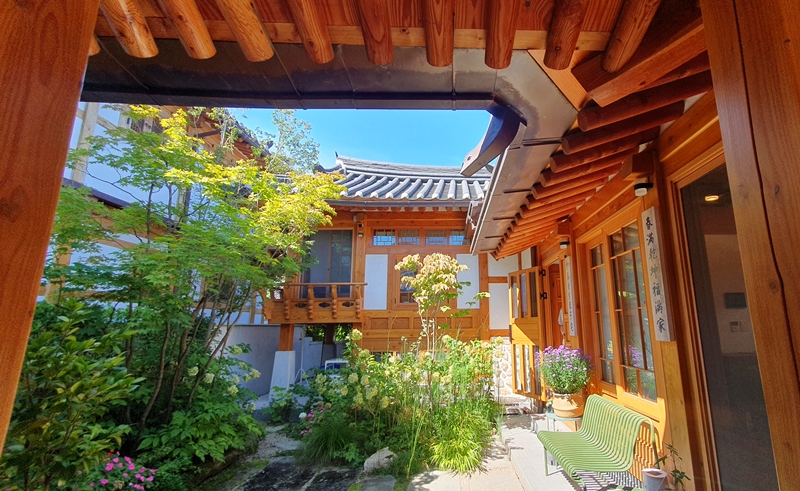
A Korea.net team on Sept. 24 visited Seoheejae in Seoul's Eunpyeong Hanok Village, the smallest Hanbok that the group visited that day but also possessing the facilities necessary for living as well as outstanding space structure and detailed decorations. The home in 2021 was named an outstanding Hanok by the Seoul Metropolitan Government under the city's annual program to find such homes used in everyday life that embody the beauty of traditional Hanok.
Seoheejae is located deep in a valley near the entrance of the village.
Right after the entering gate, a small simple garden appeared on one side of the front yard and a traditional Hanok shaped like the Hangeul letter ㄱ was next to it.
Past the front door, the team arrived at a space that had a large modern kitchen on the right and a "skip floor" as tall as half a floor on the left. Going up half a floor up the stairs led to a bedroom and half a floor down led to the living room.
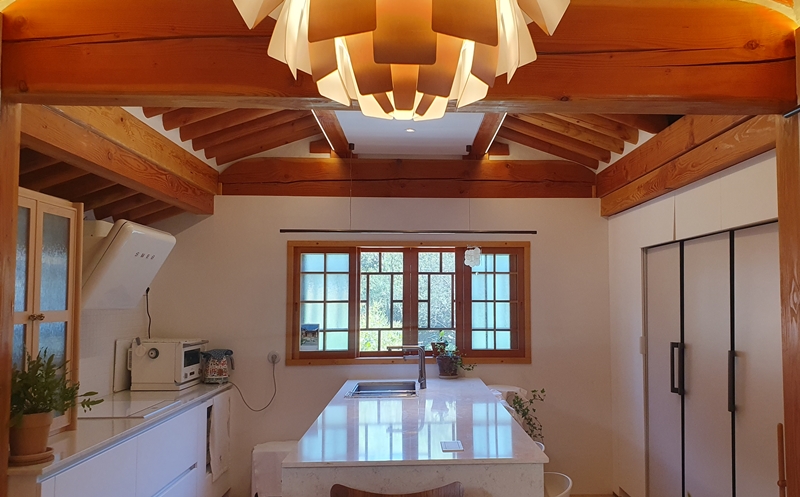
Seoheejae's kitchen forms a harmony of traditional Hanok rafters and windows and modern features like a sink, refrigerator and air conditioner.
A Korea.net reporter sat in a small resting area next to the bedroom, slightly turned her head and saw the front yard, which she had passed through the front gate. She looked at the rafters on the ceiling while listening to flowers and grass moving along with the gentle breeze, feeling at ease. This was the charm of Hanok.
Beneath the eaves of the entrance was a signboard reading "Jeongdaun House." The name in Chinese characters read "a house where jeong (affection for others) come in like clouds" and "a house with warm jeong for others" in Hangeul.
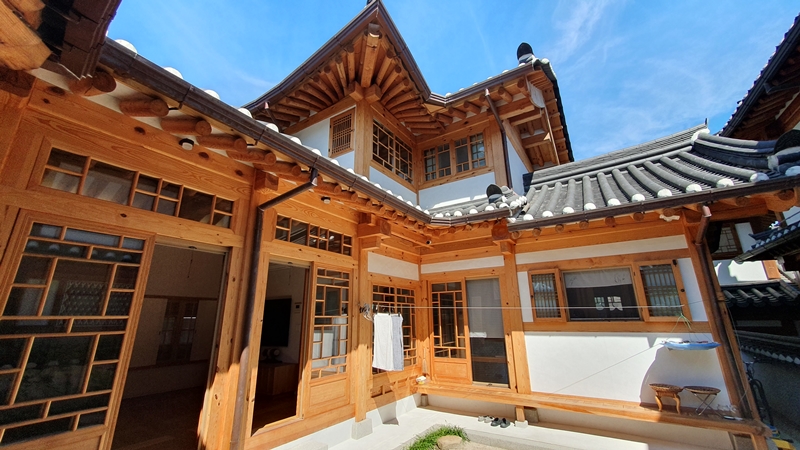
Jeongdaun House last year was named an outstanding Hanok by the Seoul Metropolitan Government and "Civic Empathy Hanok" by the public.
Jeongdaun House is a Hanok with a two-story main home and a single-story detached unit with a yard in the center. The team was allowed to enter select sections of the home's first floor and the unit. In a section closed to the public, the house owner and his family could be seen eating a meal as well as towels hanging on clotheslines to dry, showing that Jeongdaun was a residence and as warm as its name suggests.
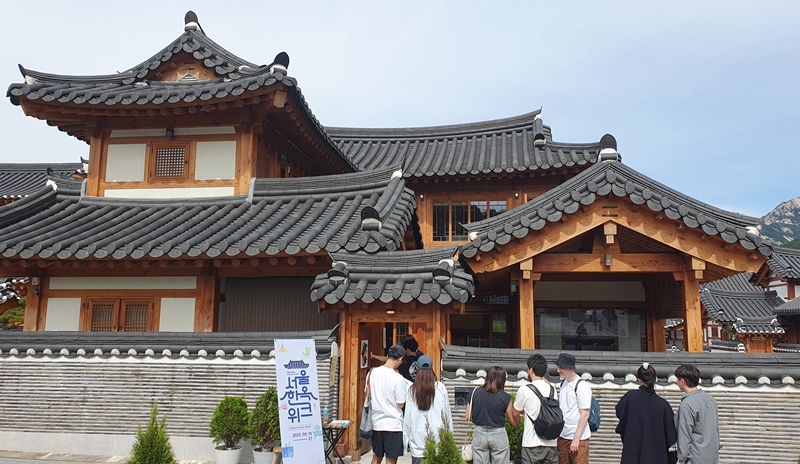
Visitors on Sept. 24 wait in line to experience the event "Open House Hanok," which was part of Seoul Hanok Week. Bzign Hanok, which was named an outstanding building of its kind by the city, was the largest of the Hanoks in Eunpyeong Hanok Village that Korea.net visited.
Bzign Hanok is a contemporary convergent Hanok that serves multiple purposes such as residence, work and cultural experience space.
The home's owner prohibited taking photos of the interior but greeted visitors and gave explanations of the house. To prepare for visitors, he left marks at spots indicating what part of the home a visitor was in and whether entry was permitted, which impressed the team.
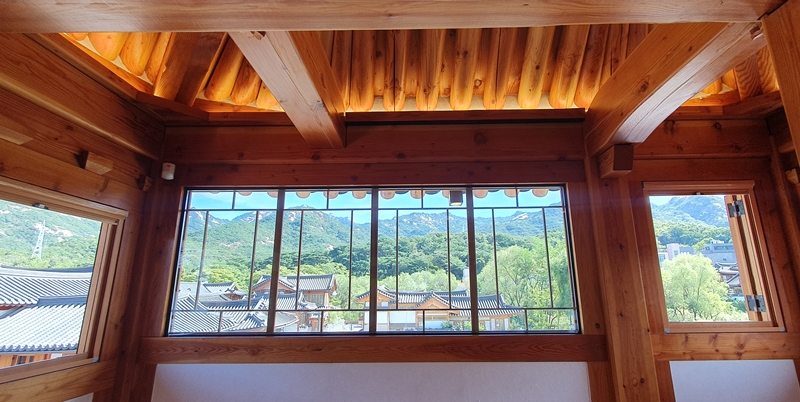
The window on Bzign Hanok's second floor was the only spot within the building where Korea.net was allowed to take photos. The view features beautiful scenery like a framed picture.
The first basement floor is said to be used by the owner as a place to work and film, and Bzign Hanok's 40.5 m-tall ceiling differentiates it from other Hanok. The second floor is for greeting guests, with the view from the window of the village and Bukhansan Mountain resembling a work of art.
The owner of the home is artist and village head Bzign, who said the Open House Hanok program is "highly meaningful in promoting Hanok through visits by many people."
Visitors this day were not only from Korea but from other countries like Ecuador, Singapore, the U.S. and Taiwan. To show one's residential space to others, especially strangers, is far from easy.
"Who'd visit here if this were an apartment?" Bzign said. "It's rare and valuable because it's Hanok."
The National Institute of Korean Language's standard dictionary defines Hanok as "a building built in a style of Korea's unique forms."
The structures Korea.net saw that day were clearly Hanok with tiled roofs, wood used as the main material, rafters on the ceiling, and traditional windows and doors. Each interior was different, however, according to modern lifestyles and needs.
Modern Hanok is not just about sticking to tradition but also creating harmony by adding modern touches while maintaining the home's traditional form. This has made Hanok a form of housing where people want to live again.
km137426@korea.kr